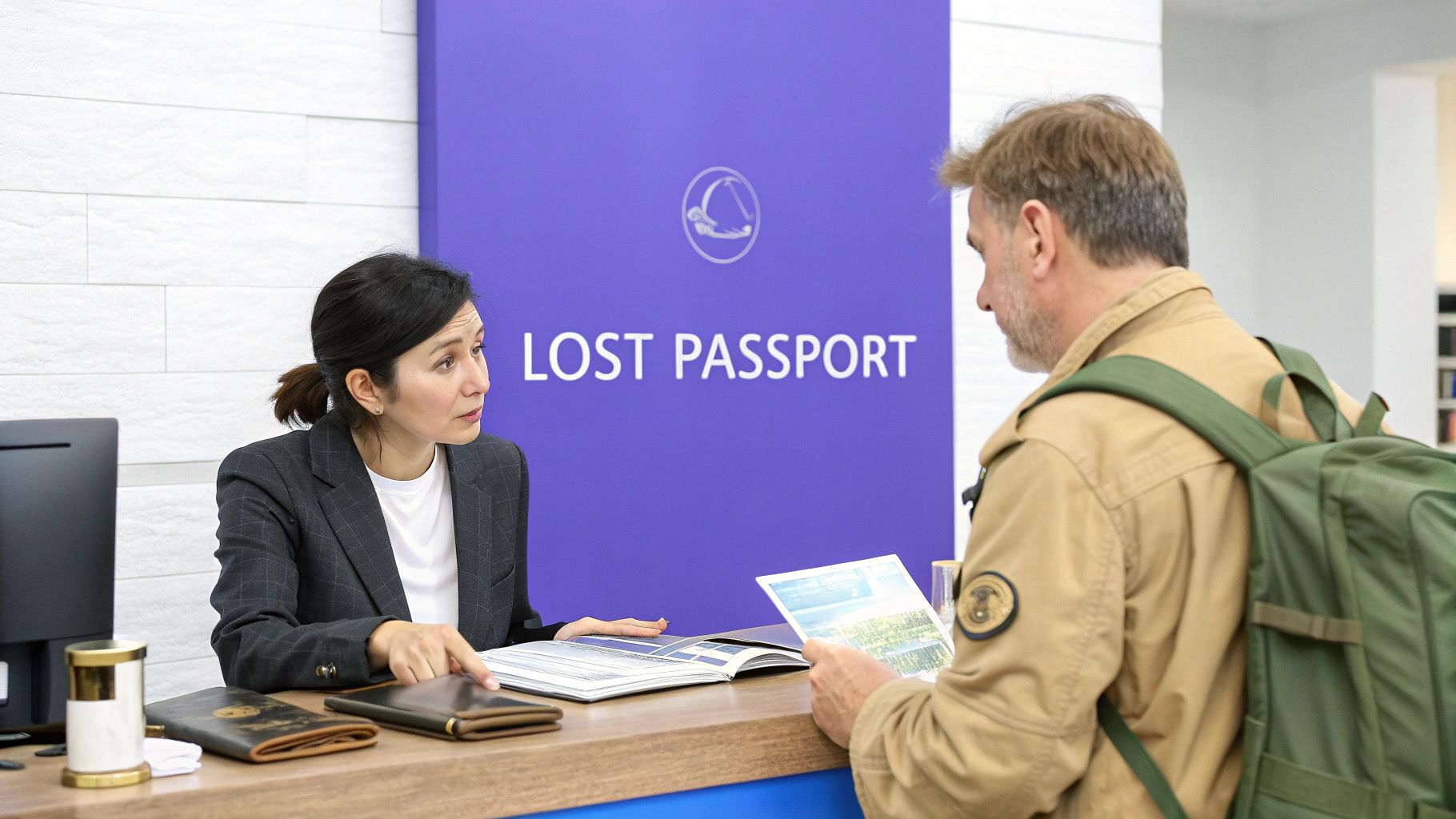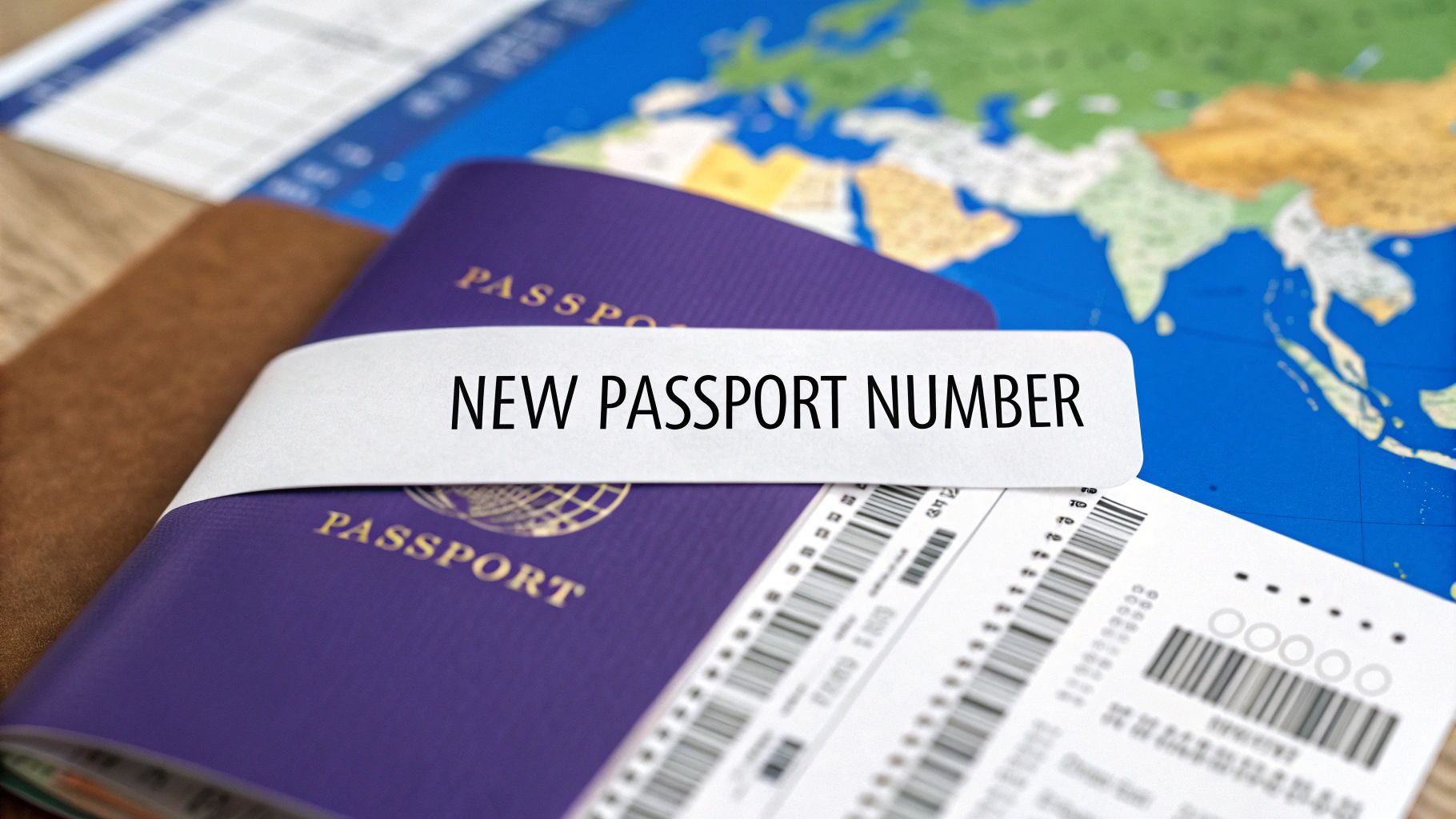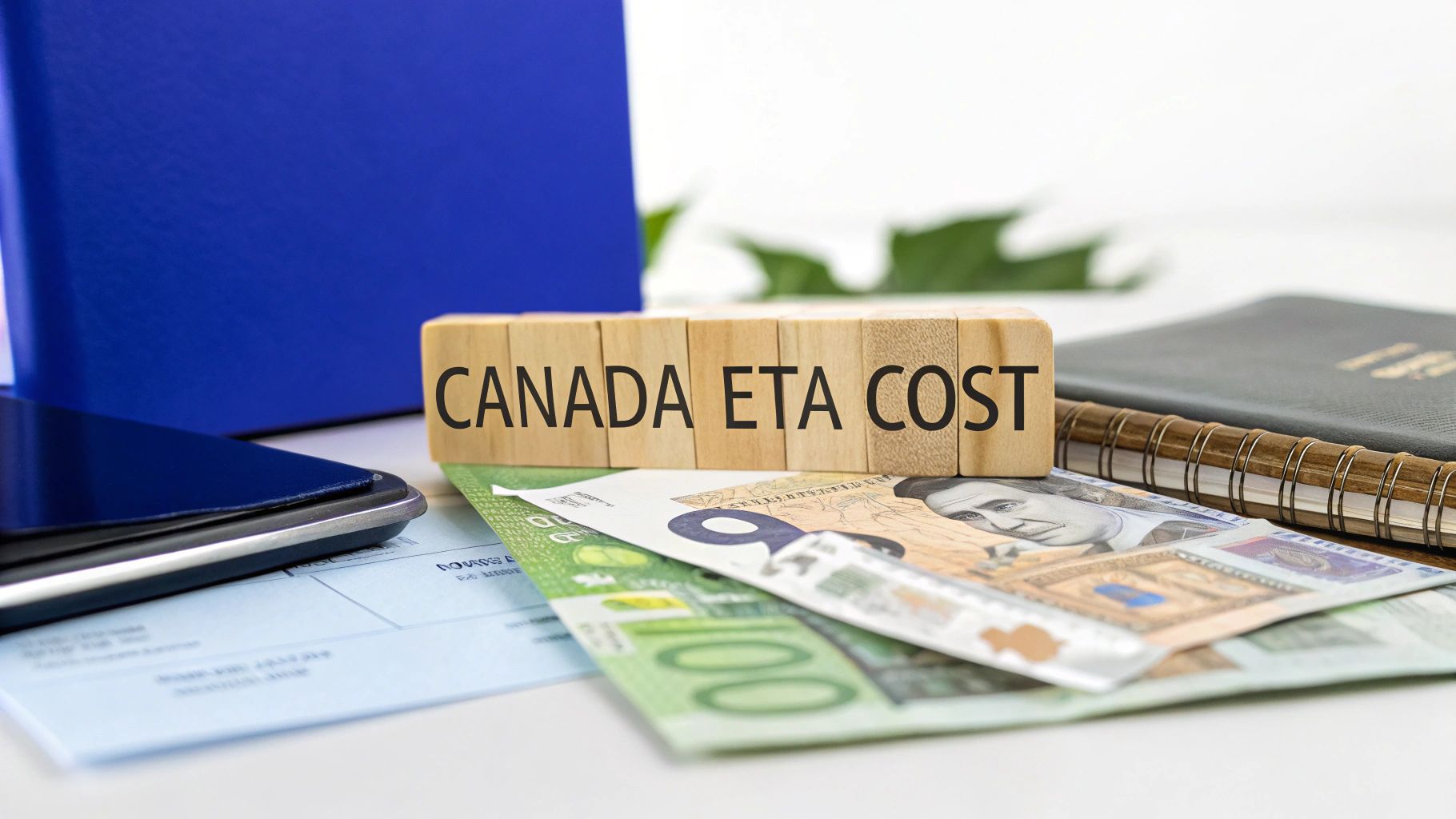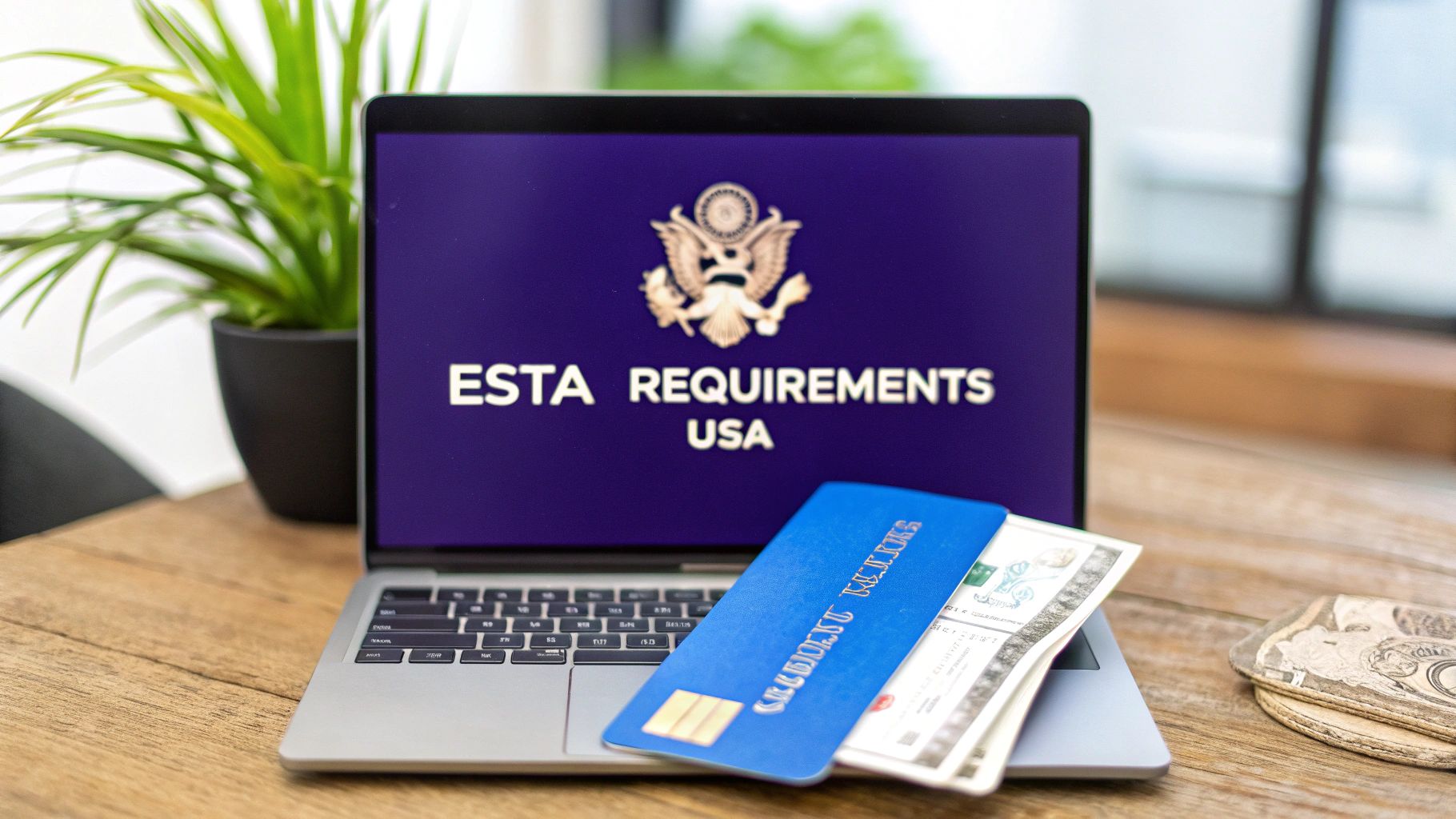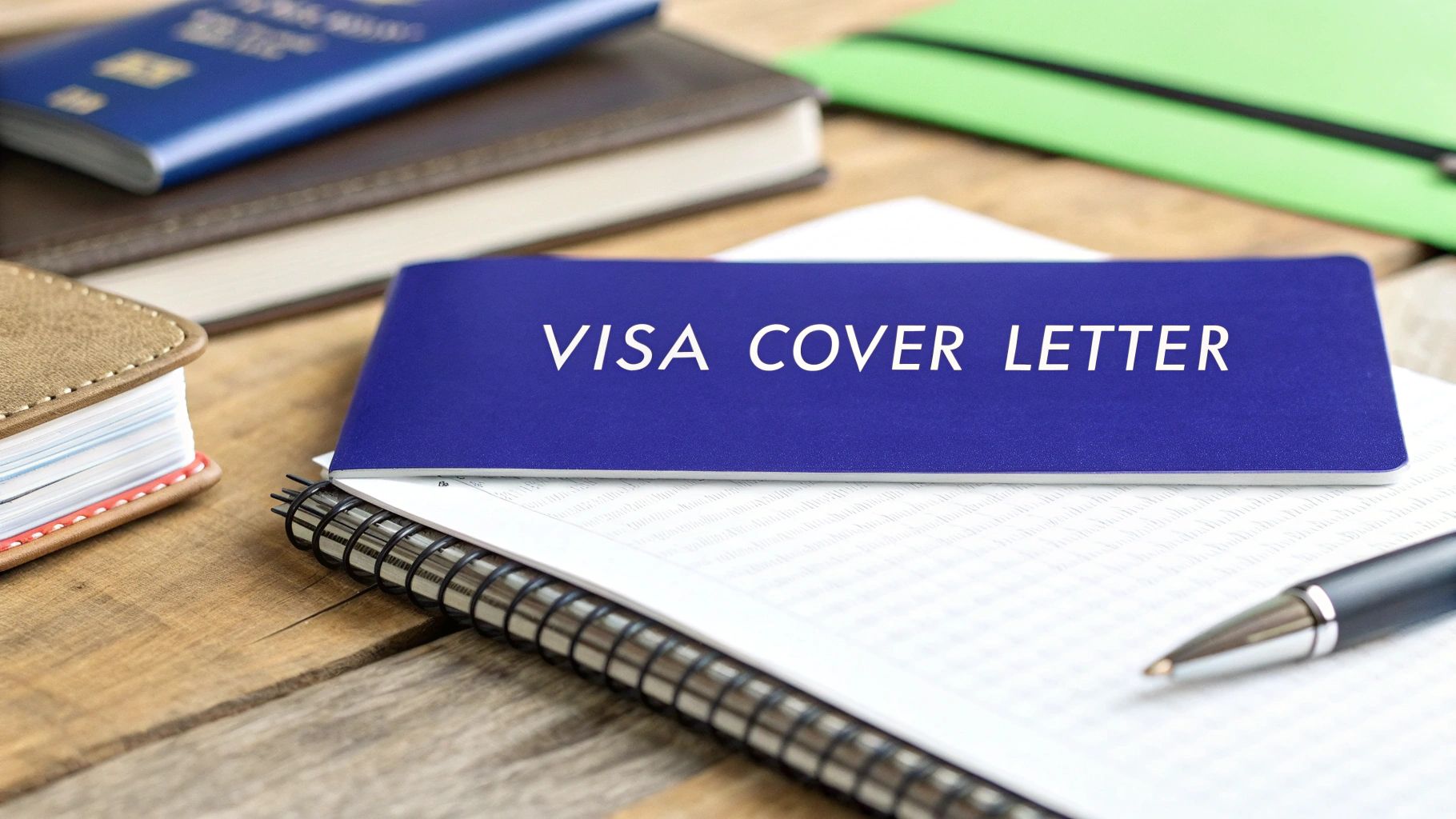
Writing Your Application Letter for Visa
An application letter for visa is your personal statement to the consular officer. Think of it as the cover letter for your entire application—it explains why you're traveling, proves you can afford it, and, most importantly, confirms you plan on coming home.
It's the one part of the process that turns a stack of documents into a personal story, and it can directly influence the officer's decision.
Why Your Visa Letter Is More Than a Formality
Staring at a blank page, it’s easy to think of the visa letter as just another box to tick. But it's so much more than that. In a pile of hundreds of applications, your application letter for visa is your only real chance to speak directly to the consular officer.
It’s where you connect the dots. A well-written letter transforms your application from a simple collection of papers into a compelling narrative, giving you the chance to answer the questions a visa officer might have before they even ask them.
The Human Element in a Bureaucratic Process
Every visa application is reviewed by a real person, and your letter provides the human context that forms and bank statements just can't. It frames your intentions, shows you’re financially stable, and proves you have undeniable ties to your home country. Without it, the officer is left to guess.
For example, a bank statement shows you have money, but your letter explains how you'll use those funds to support your trip without needing to work abroad. This story is critical, especially now. After a global drop, visa applications for some regions shot back up, hitting 10.3 million in 2023 and a projected 11.7 million in 2024. With that kind of volume, a clear and convincing letter makes you stand out.
A strong visa letter doesn't just list facts; it builds trust. It reassures the consular officer that you are a genuine visitor who respects their country's laws and will return home as planned.
This personal touch is the foundation of a letter that actually works. As you start writing, remember that the letter is just one piece of the puzzle.
Key Components of a Persuasive Visa Letter
To help you get started, here's a breakdown of the essential elements your letter absolutely must include. Nailing each of these components will give the consular officer a clear, convincing picture of your trip.
| Component | Purpose | What to Include |
|---|---|---|
| Personal Information | To clearly identify who you are. | Your full name, address, passport number, and date of birth. |
| Consulate Details | To correctly address the application. | The name and address of the embassy or consulate you're applying to. |
| Trip Purpose | To explain why you are visiting. | Be specific: tourism, business meeting, visiting family, medical treatment, etc. |
| Travel Itinerary | To show your trip is well-planned. | Dates of travel, flight numbers, accommodation details, and a brief day-by-day plan. |
| Financial Proof | To prove you can afford the trip. | Mention your financial status and reference the supporting bank statements or letters. |
| Ties to Home Country | To prove your intent to return. | Employment, family, property ownership, or ongoing studies. This is crucial. |
| Closing Statement | To end on a polite and confident note. | Reiterate your purpose and thank the officer for their time and consideration. |
Each part plays a role in building a narrative that is both personal and professional. By addressing all these points, you leave no room for doubt about your intentions as a genuine traveler.
Building the Core of Your Visa Letter
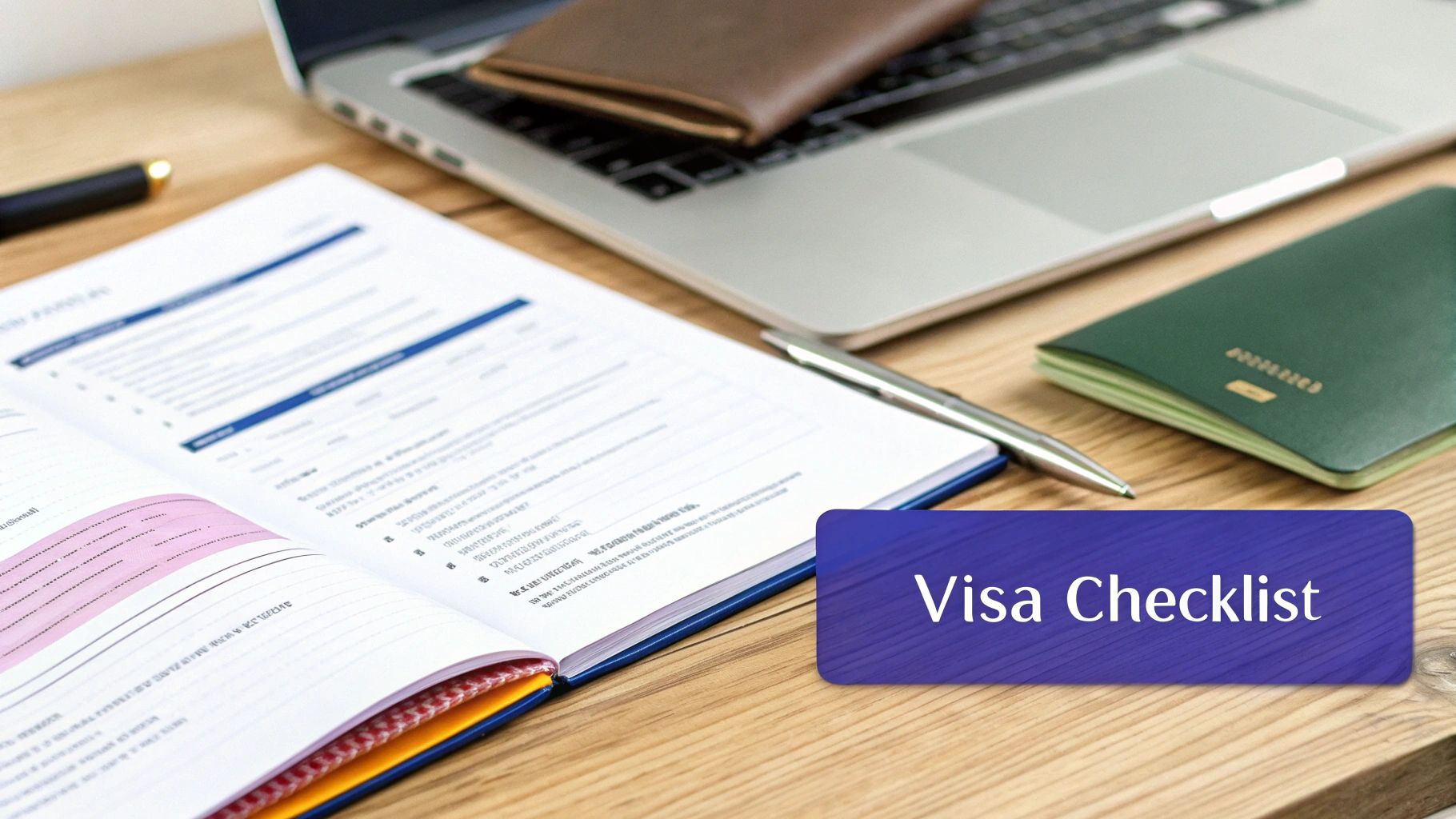
A great visa letter tells a clear and logical story. Think of it as your first and best chance to make a good impression. It should move right past a generic greeting and immediately establish why you want to travel, building a convincing case with each paragraph.
Let's walk through how to put each piece together with purpose.
Your introduction needs to be direct. This isn't the time for a long backstory. In the first couple of sentences, state your name, passport number, and the exact reason for your visit.
For example: "My name is [Your Name], holder of passport number [Your Passport #], and I am writing to apply for a tourist visa to visit the UK from [Start Date] to [End Date]."
This approach immediately gives the consular officer the most critical information they need and sets a professional tone for your entire application letter for visa.
Crafting Persuasive Body Paragraphs
The body of your letter is where you do the real work of convincing the officer. This is your chance to lay out your plans and connect them directly to the documents you’ve provided. To make it easy for the officer to follow along, organize this section into clear, distinct topics.
Start with a solid itinerary. You don’t need an hour-by-hour schedule, but you should outline your main activities. Mention the cities you’ll visit, major landmarks you plan to see, or any events you'll attend. Referencing your booked flights and hotel reservations here adds a huge layer of credibility.
Next, you need to talk about your finances. Do it with confidence. State how you'll be funding the trip, whether it's through personal savings, a sponsor, or your company. You could say something like, "I have sufficient funds to cover all expenses during my stay, as demonstrated in my attached bank statements showing a balance of [Amount]."
The single most critical part of your letter is proving you have strong ties to your home country. This is what assures the visa officer you have every intention of returning. Vague statements just won't cut it—you need to provide concrete evidence.
Here's how to show them you have solid commitments back home:
- Employment: Mention your job title, your employer, and how long you've worked there. Be sure to reference the attached letter from your employer granting you leave for the trip.
- Family: If you have a spouse, children, or elderly parents who depend on you, state this clearly. Family is a powerful anchor.
- Property: Do you own a home or other significant assets? Mentioning property ownership is a strong indicator that you are rooted in your home country.
- Studies: If you're a student, give details about your course of study and when you're expected to graduate.
Each of these points helps build a picture of a life you are invested in and will return to. Weaving these details into your narrative is crucial.
Concluding with Confidence
Your conclusion should be brief but firm. Reiterate your promise to abide by the country's laws and state clearly that you will leave before your visa expires. A simple, polite closing like, "Thank you for considering my application," is the perfect way to end your letter on a professional and respectful note.
Not All Visa Letters Are Created Equal
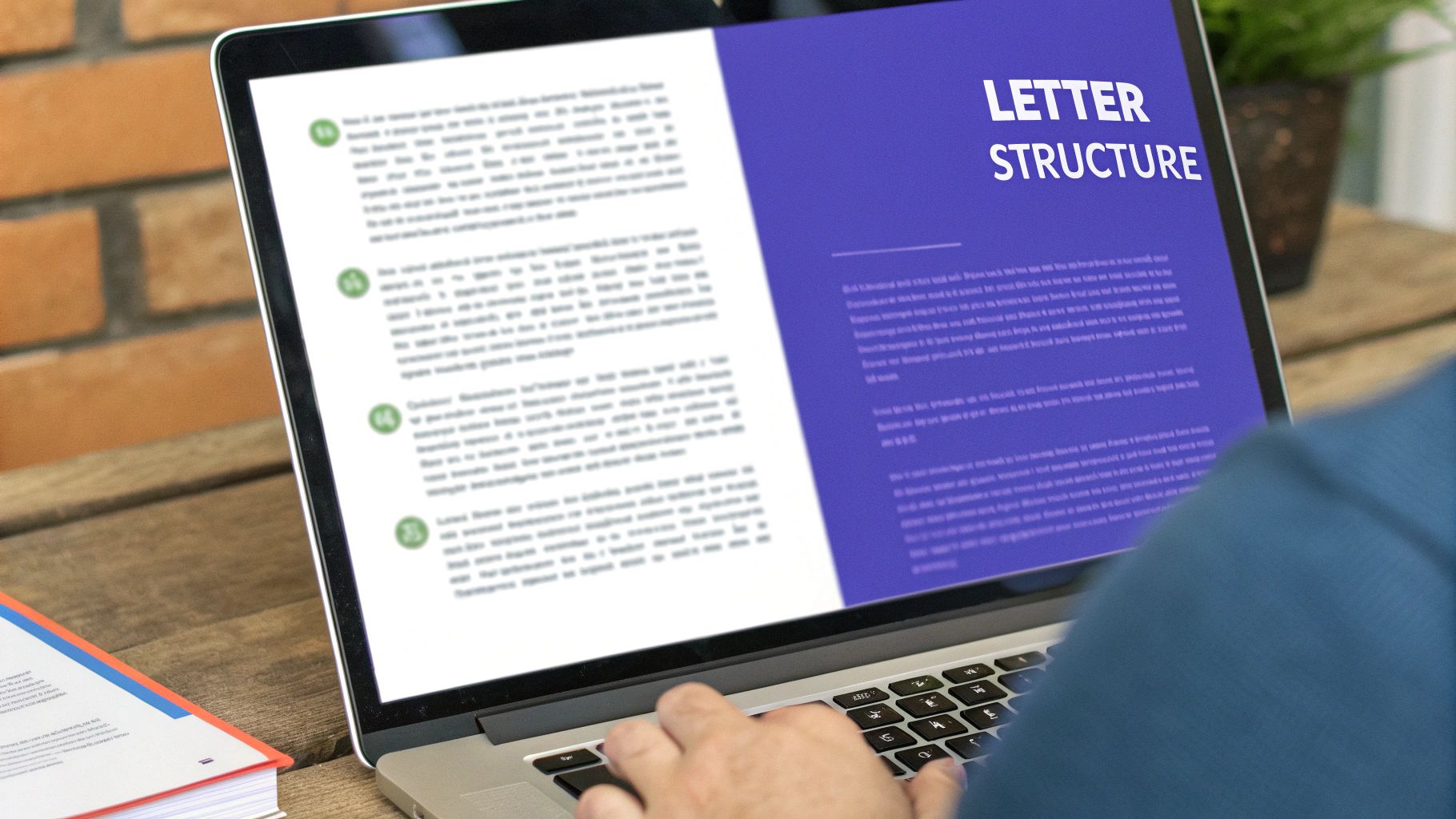
A one-size-fits-all application letter for visa is a surefire way to get rejected. The priorities for a tourist visa are worlds apart from those for a student or business visa, and your letter needs to show you understand the difference.
When you tailor your letter, you’re signaling to the consular officer that you’ve done your homework and respect the rules for your specific visa category. It makes your entire application more convincing.
Think of it this way: every visa type has one central question it’s trying to answer. For a tourist, it’s, "Are you genuinely here for a holiday?" For a student, it's, "Are you a serious student who will leave after you graduate?" Your letter’s job is to answer that core question clearly and with evidence.
Writing for a Tourist Visa
For a tourist visa, you want to paint a clear picture of a real vacation. Forget generic lines like, "I want to see the sights." You need a brief, believable travel plan that shows you've put some thought into your trip.
- Get Specific: Instead of being vague, mention specific places you plan to visit, like the Tower of London or Buckingham Palace. Are you attending a festival or exploring a particular region? Put that in.
- Show Your Plan: Reference your flight confirmations and hotel bookings. A trip with confirmed logistics looks far more credible than a fuzzy idea of a holiday.
- Keep it Leisure-Focused: The whole tone should be about excitement for your trip and your solid plans to return home once it’s over.
Articulating Your Goals for a Student Visa
A student visa letter shifts the focus from sightseeing to your academic and professional ambitions. The consular officer needs to see you as a dedicated student—not someone using education as a backdoor to immigrate.
Your letter should explain exactly why you chose this specific university and program. Crucially, you need to connect this degree to your future career path back in your home country. This is more important than ever, given how closely student applications are scrutinized.
For example, while U.S. F-1 student visa issuances were above pre-pandemic levels in early 2025, the number issued to Indian students fell by 44% compared to the previous year. This highlights just how much individual circumstances and a well-argued case matter.
A powerful student visa letter links your academic journey to your professional future. Clearly state that you intend to return home after graduation to apply your new skills—this directly reinforces your non-immigrant intent.
Defining Your Purpose for a Business Visa
When it comes to a business visa, your letter needs to be all about professionalism and precision. Your goal is to clearly define your business activities without raising any red flags that you plan to work illegally.
Make sure your letter references the official invitation you received from the host company. State the exact purpose of your visit, whether it's for contract negotiations, specialized training, or attending an industry conference. It’s also a smart move to briefly explain your role in your company and why your physical presence is essential for these activities.
Customizing your application letter for visa isn’t just a good idea—it’s critical.
Common Mistakes That Can Sink Your Application
Even a perfectly prepared visa application can hit a snag because of a few simple, avoidable mistakes. Your application letter for visa is under a microscope, and what seems like a minor error to you could look like a major red flag to a consular officer.
Knowing what these common pitfalls are is the first step to making sure you don't fall into them.
Inconsistencies and Contradictions
One of the quickest ways to raise doubts is to have conflicting information. If your letter says you’re staying for 14 days, but your flight booking shows a 21-day trip, that's a problem. Every single detail, from your travel dates to your stated purpose, has to line up perfectly across all your documents.
It sounds tedious, but you need to cross-reference your letter with your passport, bank statements, itinerary, and hotel bookings. This is where many applications fail. Our guide on how to scan your passport properly can also help ensure your digital documents are crystal clear from the start.
Vague Statements and Lack of Detail
Another frequent mistake is being too generic. Phrases like “I want to explore the country” or “I will be meeting with business partners” are basically meaningless to an immigration officer. They need specific, verifiable details that you can back up with evidence.
Instead of being vague, be precise. Connect every statement in your letter directly to a supporting document. This shows you’re organized, transparent, and have a clear, legitimate reason for your visit.
Tone and Professionalism
The way you write matters. A letter that comes across as too casual, overly emotional, or demanding can leave a bad impression. Your goal is to be professional, respectful, and factual. Present your case with confidence, but avoid pleading or making dramatic emotional appeals.
This chart breaks down the difference between a formal and informal tone, which is critical for official letters like this one.
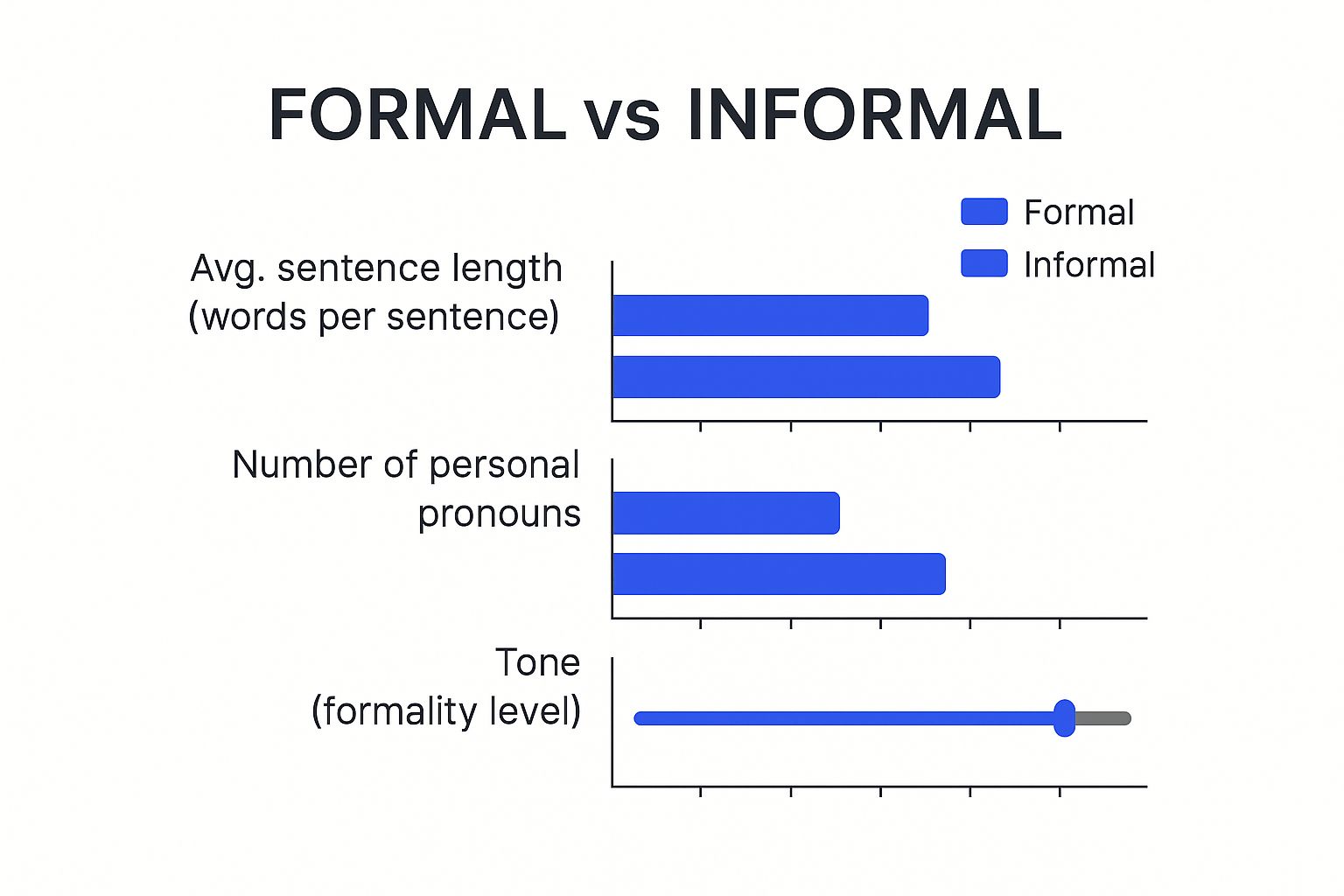
As you can see, a formal letter uses more structured sentences and avoids overly personal language. This conveys the seriousness and respect that official correspondence requires.
The stakes are higher than you might think. In May 2025, U.S. nonimmigrant visa issuances dropped by 16% compared to the previous year. Visitor visa approvals alone fell by over 136,000. These numbers show just how important a flawless, professional letter is.
A visa application is not the place for storytelling or casual conversation. Your letter should be a formal document that is clear, concise, and completely aligned with the evidence you provide.
To help you get this right, here’s a quick-reference table outlining some of the most common mistakes I see and, more importantly, how to fix them before you submit.
Common Visa Letter Mistakes and How to Fix Them
| Common Mistake | Why It's a Problem | How to Correct It |
|---|---|---|
| Using vague language | It fails to provide the concrete, verifiable details officers need. "Sightseeing" isn't enough. | Be specific. Instead of "business meetings," write "attend the Global Tech Conference from June 10-12 and meet with XYZ Corp." |
| Inconsistent dates or details | It immediately destroys your credibility and suggests you might be hiding something. | Triple-check that your letter's dates, names, and purpose match your flight itinerary, hotel bookings, and other supporting documents. |
| Forgetting to mention ties to home | Officers need to see compelling reasons for you to return to your home country. Without them, they may assume you intend to overstay. | Clearly state your commitments back home, such as your job, family, property ownership, or ongoing studies. |
| An overly emotional or casual tone | It comes across as unprofessional and can undermine the seriousness of your application. | Keep the tone formal, respectful, and factual. Stick to the point and avoid pleading or making personal appeals. |
| Not referencing supporting documents | The letter and documents should work together. A standalone letter is just a list of claims with no proof. | Directly mention the key documents you’ve included. For example, "As shown in my attached bank statement..." or "My employment letter confirms..." |
By catching these common issues, you can review your letter with a more critical eye. Fixing them will strengthen your application and give you a much better shot at approval.
UK and Canada's Digital Shift: What About Application Letters?
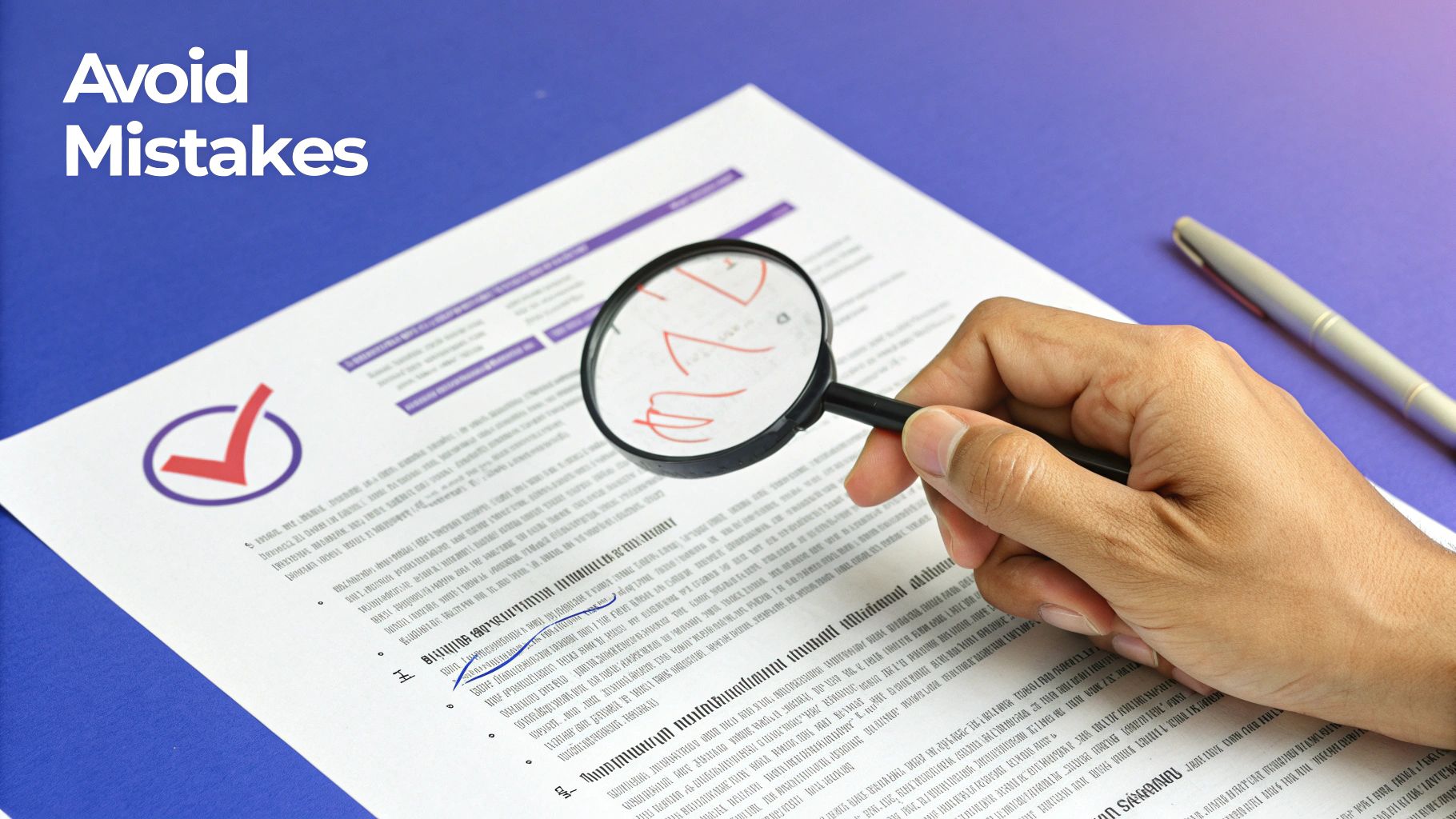
While a formal application letter for visa is the backbone of many traditional visa processes, travel to the UK and Canada is evolving. For a growing number of visitors, the lengthy visa application is being replaced by something much faster: an Electronic Travel Authorization (ETA).
This digital system does away with the need for a detailed letter. But don't let the simplicity fool you. The core principle is exactly the same—providing clear, accurate, and consistent information is absolutely critical. A tiny mistake on a digital form can cause the same headaches, delays, or even denials as a poorly written letter.
Getting to Know the ETA and eTA Systems
Both the UK and Canada have rolled out these digital authorizations to beef up security and make entry smoother for low-risk travelers. The entire process happens online, with the approved authorization getting linked directly to your passport.
- United Kingdom ETA: The UK's new UK ETA is a requirement for visitors from visa-exempt countries coming for short stays. This covers everything from tourism and visiting family to business trips or just passing through.
- Canada eTA: Canada's Canada eTA has been around a bit longer and is mandatory for visa-exempt foreign nationals arriving by air. It serves the same purpose, allowing Canadian officials to screen travelers before they even board their flight.
Since the system is automated, there's no consular officer reading your letter to understand the nuances of your trip. The system only sees the data you enter. For a better sense of what's involved, you can look through the full list of https://assistentry.com/blog/canada-eta-requirements to see just how specific these digital forms can get.
Avoiding Common Digital Mistakes
The move to online-only applications has created a new set of common trip-ups. A simple typo in your name, an incorrect digit in your passport number, or a wrong date of birth can trigger an automatic rejection or cause serious problems when you land.
Unlike a paper application where a human might overlook a minor slip-up, these automated systems are usually black and white. There's no one to explain your mistake to at the airport. It's precisely this lack of a safety net that leads many travelers to use a trusted, third-party application assistance provider to get it right the first time.
Think of your digital application as your new "letter." Every field you fill out tells the story of your trip. Your goal is to make sure that story is clear, consistent, and completely error-free.
To simplify your UK ETA application and increase your chances of approval, consider using AssistEntry — their experts guide you through the entire process, starting from just $79, which includes the government fee. If you're headed to Canada, they provide the same expert assistance on their Canada eTA page. The service includes a full verification of the application before submission, error-checking, and a compliance review to ensure your application is perfect before it's sent off.
Frequently Asked Questions About Visa Letters
When you're trying to write a solid application letter for visa, a few questions always seem to pop up. Getting these details right can take a lot of the guesswork out of the process, helping you write with a lot more confidence. Let's walk through some of the most common ones I hear from applicants.
How Long Should My Visa Application Letter Be?
The golden rule? Keep it to one page.
Consular officers are incredibly busy, reviewing hundreds of applications a day. They simply don't have time to sift through a multi-page essay. A concise, powerful letter that gets right to the point is always more effective.
Make sure it clearly states your purpose, itinerary, financial stability, and ties to your home country. No fluff needed.
Can I Use a Template for My Visa Letter?
Absolutely—but only as a starting point. A template is a great way to make sure you have the right structure and include all the necessary sections.
However, a generic, copy-paste letter is an immediate red flag for any visa officer. It just screams a lack of genuine effort.
Your job is to take that template and infuse it with your personal details, your specific travel plans, and your own voice. Personalization is what makes a letter believable and compelling.
Who Should I Address the Application Letter To?
Whenever possible, address your letter to the specific embassy or consulate handling your application. It shows you've done your homework. A simple, professional salutation like, "To the Visa Officer, Embassy of [Country Name], [City]," works perfectly.
If you can't track down the exact title or office, don't sweat it. A respectful greeting like "To the Honorable Consular Officer" or "To the Visa Section" is completely fine. The main thing is to maintain a formal, professional tone from start to finish.
Which Supporting Documents Should I Mention?
Think of your letter as the cover sheet for your entire application—it should guide the officer through all your evidence. Don't just list your documents; actively reference them as you make your points.
- When you talk about your finances, point to your attached bank statements.
- As you outline your itinerary, mention your flight and hotel confirmations.
- When proving your ties to home, refer to your employment letter or property deeds.
This connects the dots for the visa officer, making their job easier and your application much stronger.
A huge mistake I see people make is just listing their documents without explaining why they matter. Instead, weave them into your story. Saying something like, “As my enclosed employment letter confirms…” creates a cohesive narrative that’s easy for the officer to follow and verify.
Nailing these small details can make a massive difference in the quality of your application letter for visa. It helps you present a professional, clear, and convincing case that leaves no room for doubt.
For many travelers heading to the UK and Canada, a formal letter isn't required anymore. But with the new Electronic Travel Authorization (ETA) systems, accuracy is more important than ever. Simple mistakes can lead to big delays.
To avoid these common pitfalls and increase your chances of approval, consider using AssistEntry.com. As a trusted third-party application assistance provider, their experts review every detail to ensure your application is correct and compliant. For travel to the United Kingdom, you can simplify the whole process by using AssistEntry’s UK ETA page, with services starting at just $79, including all government fees.
